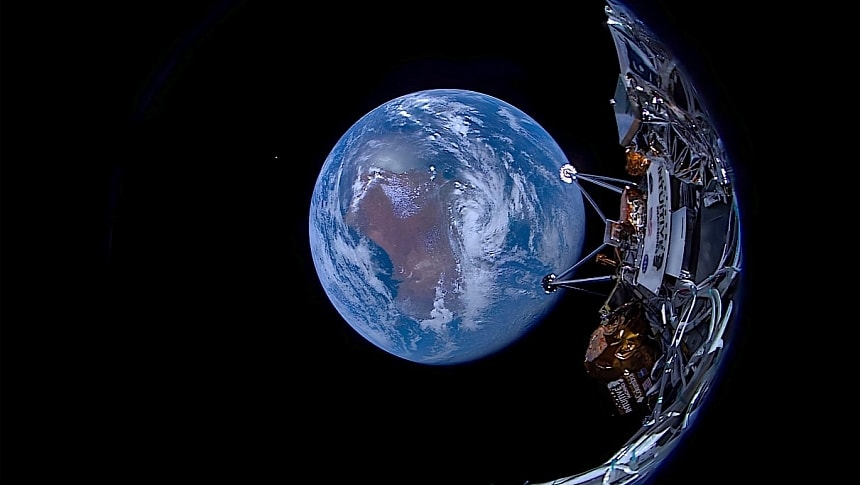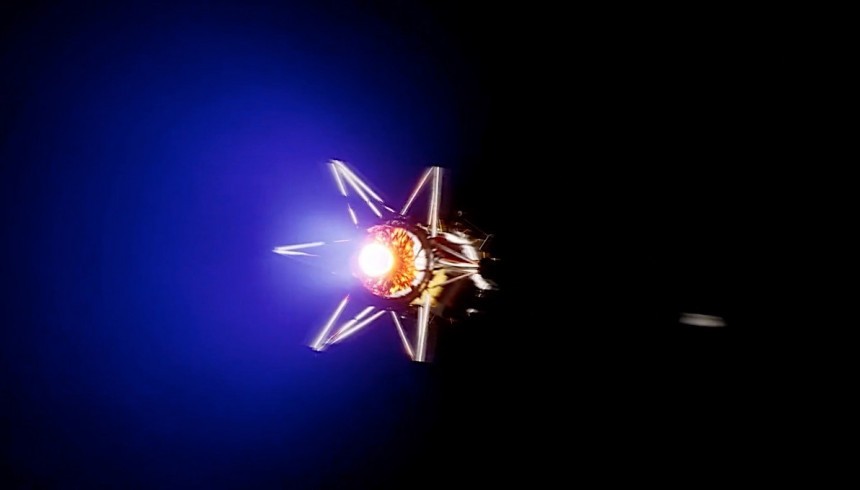It's been two weeks since America's first American commercial uncrewed mission to the Moon ended, and we're only now starting to get our first glimpse at exactly how important the flight was for the future of space exploration.
On February 15 a SpaceX Falcon 9 rocket lifted from Launch Complex 39A at the Kennedy Space Center in Florida a Moon lander called Odysseus. Part of a family of such hardware named Nova-C assembled by private contractor Intuitive Machines, Odysseus successfully reached the Moon, landing there six NASA experiments and an equal number of other pieces of cargo shipped to Luna by companies and individuals.
It's one of the NASA science instruments we're interested in right now, because we finally got an update on what it was able to achieve during the two weeks or so during which the Odysseus was operational.
The piece of tech is called Lunar Node-1 (LN-1), and it is a radio beacon meant to "support precise geolocation and navigation observations" for the people who will soon flock to the Moon during the Artemis missions.
The hardware relies on a navigation software called Multi-spacecraft Autonomous Positioning System (MAPS) to confirm the position of an object on the Moon in relation to others present on the surface: landers, rovers, surface infrastructure, and even astronauts.
What the Node is basically meant to do is provide real-time, point-to-point navigation and communication for people and vehicles up there. It can be used to link orbiters, landers, and individuals, checking their position in relation to networked networked spacecraft, ground stations, or rovers.
This type of navigation system is seen by NASA as crucial for the Artemis program, as it beats the hell out of the conventional way of determining position, relying on Earth-based data relays – a method that takes about 20 minutes for data to be received.
Although there was only one Node deployed on the Moon, its success up there could open the doors for an entire network to be created to help with navigation. And success it seems to have had, as NASA released the first details of the Node's performance.
The initial profile for the mission called for the tech to transmit data without stopping after Odysseus had landed. Its signals would have been picked up by the American space agency's Deep Space Network (DSN) for up to ten hours each day.
But the Intuitive Machines lander's arrival on the Moon was not without issues, and the fact it touched down more or less on one side impacted the Node's ability to do what it was programmed to do.
So, instead of hours of signals, the hardware only powered on for two 15-minute transmissions from the Moon, totaling just half an hour of data. The good news is that DSN antennas received the signals.
The data, which contained telemetry and navigation measurements, was then sent to the Marshall Space Flight Center in Alabama, the Jet Propulsion Laboratory in California, and the Morehead State University in Kentucky.
We do not exactly know what the data reveals, as science teams are still looking into it, but the relative success of the mission prompted NASA to say, "for 30 total minutes in February, NASA lit a beacon on the Moon."
Separately from its task after landing, the Node was also used while the lander was on its way to the Moon, sending spacecraft positioning data to DSN receivers.
NASA has big plans for this beacon network, and it is already thinking about it as something akin to "a network that monitors and maintains a busy metropolitan subway system, tracking every train in real-time." When robust enough, the system will be integrated into the upcoming LunaNet architecture.
The Intuitive Machines mission to the Moon is part of NASA's Commercial Lunar Payload Services (CLPS) program. That's an effort meant to advance the goals of the Artemis program by tapping into the private space industry.
The IM-1 mission, as the flight was called, was the first one of the CLPS to conclude successfully, but not the first one to launch. That honor belongs to the Peregrine lander and the company that made it, Astrobotic.
Launched in early January on board a Vulcan Centaur rocket, the mission came to an abrupt end after a fuel leak impacted the spacecraft's ability to reach the Moon.
After spending a little over ten days in space, the Peregrine went for a controlled crash in the atmosphere of our own planet. On January 18, the ship began its descent, heading for a remote area of the South Pacific. It likely burned up before any significant pieces of it hit the ocean.
There is one more major CLPS mission planned for this year, the launch of the VIPER rover. Intuitive Machines is scheduled to launch a second lander as well later in 2024, and we also expect a launch from Firefly Aerospace, in the form of the Blue Ghost lander.
It's one of the NASA science instruments we're interested in right now, because we finally got an update on what it was able to achieve during the two weeks or so during which the Odysseus was operational.
The piece of tech is called Lunar Node-1 (LN-1), and it is a radio beacon meant to "support precise geolocation and navigation observations" for the people who will soon flock to the Moon during the Artemis missions.
The hardware relies on a navigation software called Multi-spacecraft Autonomous Positioning System (MAPS) to confirm the position of an object on the Moon in relation to others present on the surface: landers, rovers, surface infrastructure, and even astronauts.
What the Node is basically meant to do is provide real-time, point-to-point navigation and communication for people and vehicles up there. It can be used to link orbiters, landers, and individuals, checking their position in relation to networked networked spacecraft, ground stations, or rovers.
This type of navigation system is seen by NASA as crucial for the Artemis program, as it beats the hell out of the conventional way of determining position, relying on Earth-based data relays – a method that takes about 20 minutes for data to be received.
The initial profile for the mission called for the tech to transmit data without stopping after Odysseus had landed. Its signals would have been picked up by the American space agency's Deep Space Network (DSN) for up to ten hours each day.
But the Intuitive Machines lander's arrival on the Moon was not without issues, and the fact it touched down more or less on one side impacted the Node's ability to do what it was programmed to do.
So, instead of hours of signals, the hardware only powered on for two 15-minute transmissions from the Moon, totaling just half an hour of data. The good news is that DSN antennas received the signals.
The data, which contained telemetry and navigation measurements, was then sent to the Marshall Space Flight Center in Alabama, the Jet Propulsion Laboratory in California, and the Morehead State University in Kentucky.
We do not exactly know what the data reveals, as science teams are still looking into it, but the relative success of the mission prompted NASA to say, "for 30 total minutes in February, NASA lit a beacon on the Moon."
Separately from its task after landing, the Node was also used while the lander was on its way to the Moon, sending spacecraft positioning data to DSN receivers.
The Intuitive Machines mission to the Moon is part of NASA's Commercial Lunar Payload Services (CLPS) program. That's an effort meant to advance the goals of the Artemis program by tapping into the private space industry.
The IM-1 mission, as the flight was called, was the first one of the CLPS to conclude successfully, but not the first one to launch. That honor belongs to the Peregrine lander and the company that made it, Astrobotic.
Launched in early January on board a Vulcan Centaur rocket, the mission came to an abrupt end after a fuel leak impacted the spacecraft's ability to reach the Moon.
After spending a little over ten days in space, the Peregrine went for a controlled crash in the atmosphere of our own planet. On January 18, the ship began its descent, heading for a remote area of the South Pacific. It likely burned up before any significant pieces of it hit the ocean.
There is one more major CLPS mission planned for this year, the launch of the VIPER rover. Intuitive Machines is scheduled to launch a second lander as well later in 2024, and we also expect a launch from Firefly Aerospace, in the form of the Blue Ghost lander.



